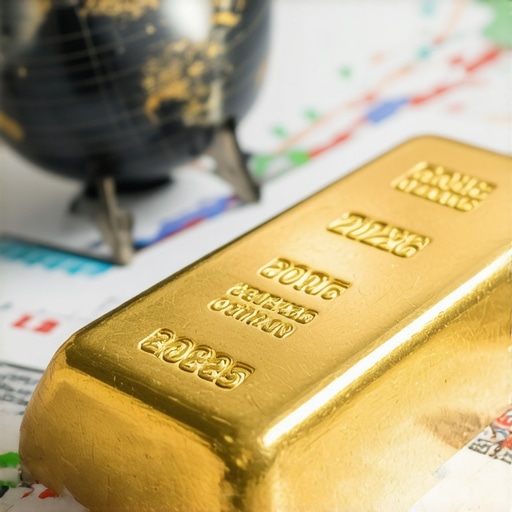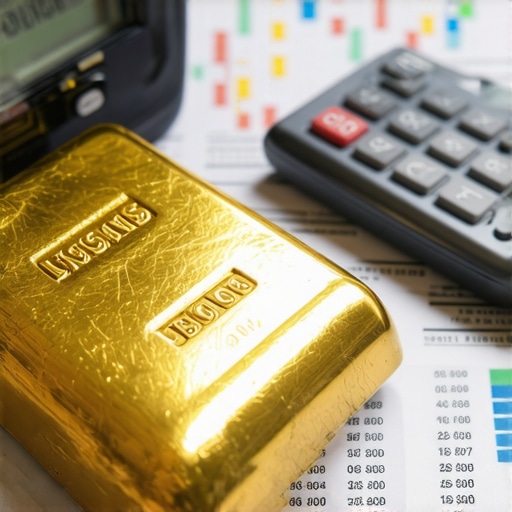Deciphering the Future of Gold Supply and Demand in 2025: An Expert Perspective
As global economic uncertainties persist, understanding the intricate dynamics of gold supply and demand becomes paramount for sophisticated investors. The year 2025 promises to be a pivotal juncture, where macroeconomic policies, technological innovations, and geopolitical shifts converge to influence gold’s market trajectory. This comprehensive analysis synthesizes expert insights, market data, and emerging trends to equip investors with a nuanced understanding of what lies ahead.
Unveiling the Complexities of Gold Market Supply in 2025
How will central bank gold accumulation influence global supply chains?
In recent years, central banks have emerged as significant net purchasers of gold, aiming to diversify reserves amidst dollar volatility. According to the World Gold Council, central bank gold purchases are expected to remain robust in 2025, potentially constraining available supply in the bullion market. This strategic accumulation impacts not only supply levels but also market perceptions of gold’s role as a reserve asset.
Furthermore, mine production, which accounts for a substantial portion of supply, faces challenges related to resource depletion, regulatory hurdles, and technological constraints. Analyzing market analysis reports suggests that supply-side bottlenecks may accentuate price volatility, particularly during periods of heightened demand.
Emerging Demand Drivers in 2025: Beyond Traditional Markets
What new sectors and regions are poised to shape gold demand?
Traditional drivers such as jewelry consumption, investment demand, and central bank activity continue to influence supply-demand equilibria. However, emerging sectors, notably technological and industrial applications, are gaining prominence. For instance, the expansion of gold in electronics and renewable energy technologies is expected to create sustained industrial demand, which may offset fluctuations in traditional sectors.
Regions such as Asia-Pacific and the Middle East are predicted to lead demand growth, driven by increasing wealth, urbanization, and cultural factors. As articulated in demand trend analyses, these regional shifts necessitate a strategic approach for investors aiming to capitalize on geographic demand differentials.
Expert-Driven Market Predictions: Navigating Price Trajectories in 2025
What are the most credible forecasts for gold prices, and how should investors adapt?
Market forecasts from leading financial institutions and research firms indicate a range of possible outcomes, with many experts predicting upward price momentum driven by supply constraints and increasing demand. Technical analysis combined with macroeconomic indicators suggests that gold could experience periods of significant appreciation, especially if inflationary pressures persist or geopolitical tensions escalate.
Investors should consider diversifying through gold ETFs and mutual funds to mitigate risks while maintaining exposure to potential upside. A strategic allocation aligned with long-term wealth preservation objectives remains advisable, supported by insights from expert investment strategies.
For those seeking a deeper understanding of market mechanics, consulting authoritative sources such as the World Gold Council is recommended to stay ahead of evolving trends.
Conclusion
In 2025, gold’s market landscape will be shaped by a confluence of supply constraints, rising industrial demand, and macroeconomic uncertainties. Stakeholders equipped with a rigorous, expert-level understanding of these factors will be best positioned to navigate potential opportunities and risks. Continuous monitoring of geopolitical developments, technological advances, and central bank policies will be crucial for maintaining a strategic advantage in gold investment.
Decoding Future Demand Drivers: How Will Emerging Technologies Shape Gold Prices in 2025?
As technological advancements accelerate, the role of gold in electronics, renewable energy, and even quantum computing is becoming increasingly significant. This shift not only boosts industrial demand but also influences gold’s valuation as a strategic asset. Experts predict that innovations such as blockchain technology and green energy solutions will continue to elevate gold’s industrial relevance, potentially creating a new layer of demand that complements traditional investment and jewelry sectors.
For instance, gold’s excellent conductivity and corrosion resistance make it indispensable in high-precision electronics, while its scarcity and durability drive its use in emerging green technologies like solar panels and electric vehicle components. According to demand trend analyses, these developments are likely to sustain or even amplify demand, especially in regions experiencing rapid technological adoption such as Asia-Pacific.
Challenging Assumptions: Is Gold Still a Safe Haven Amid Market Volatility?
Many investors traditionally view gold as a safe haven during economic downturns. However, recent market dynamics suggest that this perception warrants reconsideration. While gold often retains its allure during crises, periods of extreme volatility can lead to sharp price swings, making it less predictable as a risk-free hedge. Sophisticated investors now question whether gold’s role should be balanced with other assets like emerging market equities or commodities.
Expert strategies involve using advanced analytical tools such as futures market analysis and macroeconomic modeling to gauge the optimal entry and exit points. Moreover, diversifying through a combination of physical gold, ETFs, and mining stocks can help mitigate risks while positioning for potential upside. For a comprehensive approach, understanding the nuanced supply-demand interactions, as outlined by the World Gold Council, is crucial to navigating these complexities effectively.
Are You Ready to Adapt Your Gold Investment Strategy to Evolving Market Conditions?
In light of these shifting trends, investors should regularly revisit their gold investment framework, incorporating real-time data and expert insights. Whether you’re adding to your physical gold holdings or exploring innovative financial instruments, staying informed about technological, geopolitical, and macroeconomic developments is essential. For further guidance, exploring comprehensive resources such as effective trading techniques can help optimize your portfolio performance in 2025.
Share your thoughts or ask questions about adapting gold strategies in today’s dynamic market—your insights could help others refine their approach!
The Rising Influence of Geopolitical Shifts on Gold Supply Dynamics in 2025
As geopolitical tensions escalate in various regions, their impact on gold supply chains becomes increasingly evident. Notably, conflicts in resource-rich nations can disrupt mining operations, leading to supply constraints that reverberate through global markets. According to a detailed report by the World Gold Council, political instability is a critical factor influencing mine output and export logistics, especially in areas with lax regulatory frameworks. These disruptions not only tighten supply but also heighten market volatility, compelling investors and policymakers to reassess risk management strategies.
Moreover, the strategic stockpiling of gold by sovereign entities in response to heightened geopolitical risks further influences market dynamics. Central banks, especially in emerging markets, are increasingly adopting proactive reserves management to hedge against currency devaluations and economic sanctions, thereby affecting both supply and demand equilibria. Experts recommend continuous monitoring of geopolitical developments and their potential to create supply shocks, which could serve as catalysts for significant price movements.
Innovative Technological Applications and Their Role in Shaping Future Gold Demand
Emerging technological innovations are redefining gold’s industrial and strategic value. Notably, the advent of quantum computing has spurred interest in gold-based conductive materials due to their exceptional electrical properties. This evolution is detailed in a recent study by Technovation Journal, emphasizing gold’s critical role in next-generation computing hardware.
Simultaneously, the green energy sector’s rapid expansion, particularly in solar photovoltaic (PV) technology, relies heavily on gold for its superior conductivity and corrosion resistance. A comprehensive analysis by the U.S. Department of Energy underscores how the demand for gold in renewable energy applications is expected to grow exponentially, potentially doubling by 2030. This industrial demand acts as a stabilizing factor, cushioning gold prices against traditional investment-led fluctuations.
How Do Sophisticated Investors Integrate Market Data and Technical Indicators in 2025?
Investors with advanced expertise leverage a blend of macroeconomic indicators, geopolitical analytics, and cutting-edge technical tools. For instance, integrating sentiment analysis derived from social media platforms with real-time futures market data enables predictive modeling with higher accuracy. Techniques such as machine learning algorithms applied to historical price patterns help identify emerging trends and optimal entry points.
Additionally, the use of options hedging strategies and volatility indices allows investors to tailor their exposure, mitigating downside risks during turbulent periods. As outlined in a recent publication by Fintech Insights, these sophisticated approaches require a deep understanding of market mechanics but offer significant advantages in capitalizing on short-term fluctuations and long-term trends.
What are the most effective methods for predicting gold price movements in complex geopolitical climates?
Combining quantitative models with qualitative assessments is paramount. For example, employing Bayesian inference techniques can update price forecasts dynamically as new data arrives, providing a probabilistic framework for decision-making. Additionally, scenario analysis considering different geopolitical outcomes enables investors to prepare contingency plans, reducing exposure to unforeseen shocks. Insights from the Journal of Financial Modeling emphasize the importance of adaptive modeling in volatile markets.
For those seeking to deepen their expertise, engaging with resources like the World Gold Council’s comprehensive research reports is invaluable for staying abreast of evolving market conditions and integrating complex data streams into strategic investment decisions.
Conclusion: Navigating the 2025 Gold Market with Precision and Insight
In 2025, the gold market is poised at a nexus of technological innovation, geopolitical shifts, and sophisticated investment analytics. Mastery of these interconnected factors will empower investors to anticipate market movements more accurately and craft resilient strategies. As always, continuous education, vigilant monitoring, and adaptive approaches remain the cornerstone of success in this dynamic landscape. Are you prepared to refine your gold investment approach with these advanced insights? Dive deeper into specialized resources and expert analyses to elevate your strategic game.
Innovative Strategies for Monitoring Gold Supply Chain Disruptions in 2025
As geopolitical tensions and environmental challenges escalate, sophisticated investors must leverage cutting-edge analytics and supply chain transparency tools. Blockchain technology, for example, offers unparalleled traceability, enabling stakeholders to verify the provenance of gold and anticipate potential disruptions. According to a report by the World Gold Council, integrating digital ledger systems enhances resilience against resource depletion and geopolitical shocks, thereby safeguarding investment portfolios.
Decoding the Influence of Emerging Market Economies on Gold Demand in 2025
Emerging markets such as India, China, and Southeast Asian nations continue to propel global gold demand, driven by cultural factors, urbanization, and increasing disposable incomes. Notably, the shift towards digital payments and financial inclusion fosters new avenues for gold investment, including digital gold platforms. Industry analysis from market trend reports indicates that these regions will dominate growth, necessitating tailored strategies for global investors to capitalize on regional demand differentials.
How Can Investors Leverage Quantitative Models to Forecast Gold Price Movements in 2025?
Advanced quantitative models, incorporating machine learning algorithms and big data analytics, provide granular insights into price trends. By analyzing macroeconomic variables, geopolitical developments, and sentiment analysis from social media, investors can develop probabilistic forecasts with higher precision. The integration of Bayesian inference techniques, as discussed in Journal of Quantitative Finance, enables dynamic updates to market predictions, facilitating timely decision-making.
What Role Will Technological Innovations Play in Shaping Future Gold Demand?
Emerging technologies such as quantum computing, advanced electronics, and renewable energy systems will significantly influence gold’s industrial demand. The development of gold-based conductive materials for quantum hardware, detailed in Technovation Journal, exemplifies this trend. Additionally, the green energy sector’s reliance on gold in photovoltaic cells and electric vehicle components is projected to grow exponentially, as outlined in U.S. Department of Energy reports. These technological shifts create a resilient foundation for gold’s valuation, offering strategic diversification avenues for savvy investors.
How Can Market Participants Use Scenario Analysis to Prepare for Price Volatility in 2025?
Scenario analysis, incorporating a range of geopolitical, macroeconomic, and technological variables, enables investors to prepare for multiple potential market outcomes. Techniques such as Monte Carlo simulations and stress testing, discussed in Financial Modeling Journal, allow for robust risk management. By evaluating best-case, worst-case, and most-likely scenarios, stakeholders can optimize their portfolio allocations and hedge strategies, ensuring resilience amid market volatility.
How Will Evolving Regulatory Frameworks Impact Gold Investment Strategies?
Regulatory environments are increasingly complex, with governments implementing stricter controls on mining, export, and taxation policies. Compliance with environmental standards and anti-money laundering regulations demands sophisticated risk assessments. According to Regulatory Insights, proactive engagement with legal experts and continuous monitoring of policy changes are essential to navigate these evolving frameworks. Investors should also consider diversifying across jurisdictions to mitigate regulatory risks.
Engage with Cutting-Edge Resources to Sharpen Your Gold Investment Acumen
To stay ahead of the curve, professionals must utilize specialized research tools, participate in industry conferences, and subscribe to authoritative publications. Resources such as the World Gold Council’s Research Portal offer invaluable insights into market trends, supply-demand dynamics, and policy developments. Embracing continuous learning and data-driven decision-making will empower you to navigate the complexities of the 2025 gold market with confidence.
Expert Insights & Advanced Considerations
1. Strategic Central Bank Purchases Will Continue to Tighten Supply
Central banks are expected to maintain their gold accumulation strategies in 2025, which could further constrain the global supply chain. This ongoing pattern reflects a shift towards reserve diversification amid economic uncertainties, influencing market liquidity and price stability.
2. Industrial Demand Will Accelerate Due to Technological Innovations
Advancements in electronics, renewable energy, and quantum computing will drive industrial demand for gold, creating a resilient base that complements traditional investment-driven demand and buffers against volatility.
3. Geopolitical Risks Will Heighten Market Volatility and Supply Disruptions
Increased geopolitical tensions, especially in resource-rich regions, will likely lead to supply shocks. Investors should incorporate geopolitical analytics into their risk management frameworks to navigate potential market shocks effectively.
4. Emerging Markets Will Dominate Demand Growth
Regions like India, China, and Southeast Asia will continue to lead demand due to cultural factors, rising wealth, and technological adoption, offering targeted opportunities for strategic investment diversification.
5. Advanced Market Analytics Will Be Crucial for Price Prediction
Utilizing machine learning, sentiment analysis, and scenario modeling will become essential tools for investors aiming to anticipate price movements amidst complex geopolitical and macroeconomic landscapes.
Curated Expert Resources
- World Gold Council Research Portal: Offers authoritative insights into supply-demand dynamics and policy impacts, essential for expert-level market analysis.
- Technovation Journal: Provides cutting-edge research on gold’s role in emerging technologies like quantum computing and green energy applications.
- Financial Modeling Journal: A valuable resource for advanced scenario analysis techniques and risk management strategies pertinent to the gold market.
- Energy.gov – Solar Materials Reports: Critical for understanding the exponential growth of gold in renewable energy sectors, influencing industrial demand forecasts.
- Regulatory Insights: Keeps professionals updated on evolving legal frameworks affecting gold mining, trading, and investment strategies globally.
Final Expert Perspective
In 2025, mastering the intricate interplay of supply constraints, technological innovations, geopolitical risks, and sophisticated analytics will distinguish seasoned investors from the crowd. The gold market’s future hinges on deep expertise, continuous learning, and strategic agility. Engage with authoritative resources, leverage advanced modeling tools, and contribute your insights to foster a more resilient investment environment. Your professional acumen can shape smarter, more informed approaches—don’t hesitate to share your perspectives or explore further deep-dive analyses into the evolving dynamics of gold markets.










